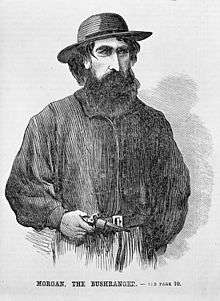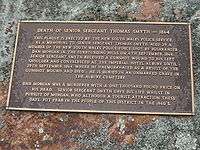Dan Morgan (bushranger)
| Dan Morgan | |
|---|---|
 Dan Morgan, 1864 | |
| Born |
John Fuller 30 April 1830 Appin, New South Wales, Australia |
| Died |
9 April 1865 (aged 34) Peechelba, Victoria, Australia |
| Occupation | Bushranger |

Dan Morgan, born John Fuller (30 April 1830 – 9 April 1865) was an Australian bushranger. After he killed a trooper in July 1864, the New South Wales government put a £1,000 bounty on his head. He was shot and killed after holding up the McPherson family at Peechelba Station in Victoria.
His exploits inspired the 1976 Ozploitation film Mad Dog Morgan, starring Dennis Hopper in the title role.
Early life and education
John Fuller was born in Appin,[1] New South Wales, Australia on 30 April 1830[2] to George Fuller and Mary Owen.
At one time there was a press controversy as to Morgan's proper name, some holding that it was Moran, while others maintained that it was Owen. All are agreed that Morgan was not his real name. Official records show that he was the illegitimate son of a woman named Mary Owen, but known as "The Gipsy." His father was George Fuller, well known about the Haymarket in Sydney, where he plied a vegetable and fruit barrow.
As a child, John Fuller was adopted by a man known as "Jack the Welshman". In 1847 the youth left his foster parent at Campbelltown, and found employment on a station on the Murrumbidgee as a stock-rider. Proving efficient, he worked at the station for seven years. Although suspected of stock theft from the late 1840s, Fuller's known criminal record began on 10 June 1854 when, under the name "John Smith" (occupation: jockey), he was sentenced to twelve years' hard labour for highway robbery at Castlemaine, Victoria.
Released in June 1860 from the prison ship Success on a ticket-of-leave for good behaviour, Fuller failed to report to the police in the Ovens police district. [1] On June 22, 1863, the following news item appeared - "On Friday afternoon news came into Albury that three of the young Purtells and two young men named Pabst were stuck up by a couple of men answering to the description of Morgan and his mate. The lads were preceding from Ten Mile Creek to attend some races at Merritt's Cookardinia Inn. They were robbed of three races horses and three saddles and bridles; also of fifteen shillings in cash. One of the horses has since returned to Ten Mile Creek minus the saddle and bridle". In August that year, he stole a prized horse belonging to the Evans family, who held the Whitfield run in the upper King River valley. Evan Evans, with fellow squatter Edmond Bond, tracked Fuller to his camp. Jack was badly wounded but escaped into the eastern Riverina and western slopes of New South Wales. His mother, in the meantime, had married, and was living at Bathurst, so young Owen decided to visit her, and stole two horses to make the trip. Along the road, he had one encounter with a party of police who were after him for stealing the horses, but he managed to evade arrest.
He was not heard of again until 1863, when he came forth as a bushranger, using aliases such as "John Smith", "Sydney Native", "Dan the Breaker", "Down the River Jack", "Jack Morgan" and, most famously, "Dan Morgan".[1] He rarely operated in company, but on 22 August 1863, he had a companion, known as "German Bill," when the pair were surprised by a party of police. A desperate shootout ensued. Mr Baylis, a police magistrate, was assisting the attacking party, when Morgan shot him, but he recovered from his wound. Finding the police persisting in their attack, Morgan turned on his mate and shot him so that the police would devote their attention to the German, and thus he escaped.[3]
Morgan operated in the Henty, Culcairn, Morven, Gerogery and Tumbarumba area over several years.
Shooting of John McLean
.jpg)
On 12 June 1864, Morgan called at the Round Hill Station a few kilometres from Morven, and rounded up all the station hands and their wives. Morgan herded all of his captives into the carpenters shop and ordered the manager, Sam Watson, to bring rum from the cellar. Morgan drank the rum before demanding fresh horses, which he said he would return on his next visit. While mounting one of these horses, Morgan discharged one of his pistols in error; drunk, he thought he was being fired upon, and shot and wounded John Heriot, one of his captives, in the leg.
Morgan demanded that the manager Watson stand still so that he could shoot him dead but Watson's wife stood in front of her husband and pleaded with Morgan to spare her husband for the sake of their children. Moved by her bravery, Morgan ordered Watson to raise his hands and shot him through one hand, shattering it by the force of the blast.
Morgan realised his mistakes, and so ordered John McLean, a young station hand, to fetch a doctor who lived some 32 kilometres away at Walla Walla Station. However, after McLean rode away, Morgan began to fear he would return with police. He mounted his horse and gave chase (rather than ride away to his hideout). Catching up with McLean, he shot him in the back, but brought him back to the Round Hill Station and stayed until McLean died. Morgan left just before a party of police arrived in search of him.
Shooting of Sergeant David Maginnity
On 24 July 1864, Morgan approached two mounted troopers, Sergeant David Maginnity and Trooper Churchley, in the bush area between Tumbarumba and Tooma. For no apparent reason, he shot Maginnity under the heart. Churchley fled the scene (although he later insisted that his horse had bolted when the shot sounded), and left his colleague, who died from his wound. Churchley was later dismissed for cowardice.
After the attack was reported in the Sydney press, Morgan became identified as a brutal murderer; the government put a reward of £1000 on Morgan's head.[4]
The site of the shooting holds occasional commemorations of the event. An alternative account has circulated in which Morgan did not shoot Maginnity, but the latter was hit by a bullet from another man.
Shooting of Senior Sergeant Thomas Smyth

Morgan shot Sergeant Thomas Smyth in September 1864; the site has been marked by a memorial stone. It is two kilometres west of the Henty on Pleasant Hills Rd (the Lockhart road).
A more recent plaque, erected by the NSW Police Service, reads:
"A memorial to Senior Sergeant Thomas Smyth, aged 29. A member of the NSW Police Force shot by bushranger Dan Morgan in the surrounding hills on 4 September 1864. Senior Sergeant Smyth received a gunshot wound to his left shoulder and convalesced at the Imperial Hotel, Albury until 29 September 1864 where he haemorrhaged as a result of the gunshot wound and died. He is buried in an unmarked grave in the Albury cemetery. Dan Morgan was a murderer with a £1000 price on his head. Senior Sergeant Smyth gave his life while in the pursuit of Morgan who although a tourist attraction these days put fear in the people of the district in the 1860s."
Death

On 8 April 1865, Morgan held up the McPherson's family at Peechelba Station in Victoria. Alice Keenan, a nursemaid to their baby Christina, was allowed to leave the room to attend to the infant. She escaped from the station and told Mr Rutherford, the co-owner of the property, of the hold-up.
The following morning as Morgan was leaving the property, he was surrounded by police. He was shot once in the back, just above the shoulder blade, by John Windlaw (also reported as Quinlan), a station employee. Morgan died of the wound that day.[5] He was buried at Wangaratta Cemetery.
Cultural influence
The films Dan Morgan (1911) and Mad Dog Morgan (1976) are based on his life and death. Morgan also appears as a character in the play Humping the Bluey, or Ransom (1911).[6] His life is fictionalised in Will Dyson's historical novel Red Morgan Rides (1940), and it is likely he was the inspiration for the villainous bushranger "Dan Moran" in Rolf Boldrewood's novel Robbery Under Arms, first published in serial form in 1882. Two biographies have been written about Morgan: Margaret Carnegie's Morgan: The Bold Bushranger (1974), and Edgar F. Penzig's Morgan the Murderer (1989).
Banjo Paterson wrote the words of "Waltzing Matilda", Australia's most famous folk song, to a tune played on the zither by the grown Christina Macpherson (who was an infant in the 1865 incident above).[7]
References
- 1 2 3 "Morgan, Daniel (Dan) (c. 1830 - 1865)" (html). History. Australian Dictionary of Biography, Online Edition. Retrieved 11 September 2006.
- ↑ Campbelltown City Council. Retrieved 26 July 2015
- ↑ "BLOODTHIRSTY MORGAN.". Singleton Argus (NSW : 1874 - 1954) . NSW: National Library of Australia. 14 June 1924. p. 3. Retrieved 16 April 2012.
- ↑ Sydney Morning Herald, 17 February 2005; retrieved 22 January 2007.
- ↑ "MORGAN, THE BUSHRANGER.". The Argus (Melbourne, Vic. : 1848 - 1956). Melbourne, Vic.: National Library of Australia. 14 April 1865. p. 6. Retrieved 15 April 2012.
- ↑ "A DELPHI—AN AUSTRALIAN MELODRAMA.". Sunday Times (Sydney, NSW : 1895 - 1930). Sydney, NSW: National Library of Australia. 8 October 1911. p. 2. Retrieved 6 September 2013.
- ↑ http://panique.com.au/trishansoz/waltzing-matilda/christina-macpherson.html
External links
| Wikimedia Commons has media related to Dan Morgan (bushranger). |
 Harris, Charles Alexander (1894). "Morgan, Daniel". In Lee, Sidney. Dictionary of National Biography. 39. London: Smith, Elder & Co.
Harris, Charles Alexander (1894). "Morgan, Daniel". In Lee, Sidney. Dictionary of National Biography. 39. London: Smith, Elder & Co. - "Henty", Sydney Morning Herald, 17 February 2005
- Article and photos of Dan Morgan, State Library of Victoria.